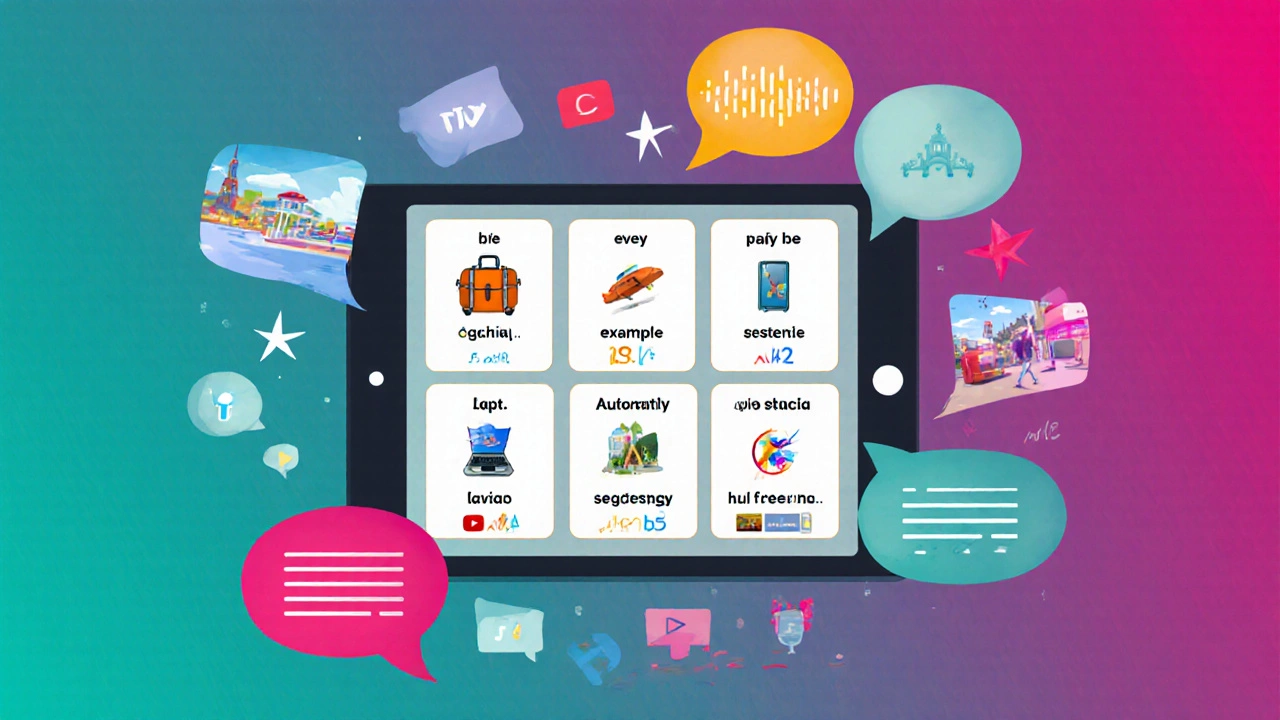English Skill Diagnostic Tool
Your Weakest Skill:
Recommended Resources:
Daily Practice Tips:
Skill Ratings:
Listening
Speaking
Reading
Writing
Grammar
Vocabulary
When you set out to improve English skills, the first step is to see language learning as a set of habits you can tweak, not a mountain you have to climb in one go. Below you’ll find a practical roadmap that turns vague ambition into daily actions, so you can speak, read, write, and listen with confidence.
Key Takeaways
- Identify your weakest skill (listening, speaking, reading, writing, grammar, or vocabulary) and focus on it for two weeks.
- Use spaced‑repetition flashcards for new words and review them daily.
- Combine input (watching, reading) with output (speaking, writing) every day.
- Pick one technology tool and stick with it for at least a month before switching.
- Create an immersion loop: think, talk, and write in English for at least 30 minutes each day.
1. Diagnose Your Starting Point
Before you invest time, know which part of English feels most uncomfortable. You can use free online placement tests from Cambridge English a reputable organization that offers level‑specific assessments or the EF SET a quick, AI‑driven test that scores you on reading, listening, grammar, and vocabulary. Mark the scores, then prioritize the lowest‑scoring skill for a focused two‑week sprint.
2. Build a Robust Vocabulary Base
Vocabulary is the building block of every other skill. The secret isn’t memorizing endless word lists, but learning words in context.
- Pick a theme each week-travel, business, technology, or everyday chores.
- Collect 15‑20 new words from authentic sources (news articles, podcasts, movies).
- Enter each word into a spaced‑repetition app like Anki or Quizlet; add an example sentence and an image.
- Review daily. After a week, try to use at least five of those words in a conversation or journal entry.
Remember, a well‑rounded vocabulary the set of words a learner can understand and produce grows faster when you see, hear, and use a word within 24 hours of first encountering it.
3. Master Grammar Through Mini‑Projects
Grammar feels abstract until you apply it. Pick a short writing project each week-an email, a tweet thread, or a 150‑word diary entry-focused on one grammatical point (past perfect, conditionals, phrasal verbs). Use online checkers like Grammarly an AI‑powered grammar assistant that highlights errors and explains rules to receive instant feedback.
After you revise, rewrite the same piece without the tool. This two‑step process converts passive rule awareness into active usage.

4. Sharpen Listening Skills with Targeted Media
Listening is often the bottleneck for non‑native speakers. Choose content that matches your level but pushes the edge-TED‑Ed talks for intermediate learners, NPR podcasts for advanced listeners.
- Play the audio at 1.25× speed to train for real‑world speech without sacrificing comprehension.
- Pause every 30 seconds, note down any unknown phrase, then replay with subtitles.
- After the episode, summarize the main points out loud for 60 seconds.
Using a listening journal a notebook where you track audio sources, difficulty level, and new expressions helps you see progress and spot recurring trouble areas.
5. Boost Speaking Confidence via Language Exchange
Speaking lives in the zone between comfort and challenge. Find a language partner on platforms like Tandem a mobile app that connects language learners for video chat or local meetup groups. Follow this simple routine:
- Set a 15‑minute timer; the first 5 minutes you ask questions, the next 5 minutes you answer, the final 5 minutes you discuss a pre‑chosen topic.
- Record the session (with permission) and note three pronunciation or grammatical hiccups.
- Practice those hiccups using a mirror or a speech‑analysis tool like ELSA Speak an AI coach that gives real‑time pronunciation feedback.
Consistency beats intensity-3‑minute daily chats beat a 2‑hour marathon once a month.
6. Read Actively for Speed and Comprehension
Reading builds vocabulary, grammar, and cultural nuance. Choose materials slightly above your current level-news websites like The Guardian a British daily with a mix of short and long articles, short stories, or graded readers.
- Skim the headline and first sentence to guess the main idea.
- Read the article once, then go back and highlight unfamiliar words.
- Write a one‑sentence summary in your own words.
Active reading turns passive exposure into a memory‑friendly exercise.
7. Write Daily, Review Weekly
Writing cements the language patterns you’ve been hearing and speaking. Start with a 5‑minute free‑write each morning-no editing, just flow. Use the following structure to keep it purposeful:
- Sentence starter: “Today I noticed…”
- New word integration: Insert at least one word from your vocabulary list.
- Grammar focus: Apply the week’s grammatical mini‑project.
At the end of the week, pick one entry, run it through Grammarly for a quick check, then rewrite the piece without any digital help. The contrast shows you where you truly own the language.

8. Leverage Technology: A Quick Comparison of Top Apps
| App | Strength | Weakness | Best For |
|---|---|---|---|
| Duolingo | Gamified lessons, huge free library | Limited speaking feedback | Beginners who need daily habit |
| Babbel | Real‑life dialogues, solid grammar explanations | Subscription cost, fewer advanced topics | Intermediate learners seeking conversational fluency |
| Memrise | Community‑created video clips, strong vocabulary focus | Inconsistent quality across courses | Visual learners who love authentic accents |
Pick one that matches your current level, stick with it for at least four weeks, and supplement it with real‑world practice.
9. Create an Immersion Loop in Your Everyday Life
Immersion doesn’t require moving to an English‑speaking country. You can embed English into your routine:
- Change phone, computer, and social media language settings to English.
- Label objects around your home with sticky notes (e.g., “fridge”, “door”).
- Think aloud while cooking: “I’m chopping the onions now.”
- Watch one TV show with English subtitles, then re‑watch without them.
When English becomes part of your environment, practice feels less like a chore and more like a natural habit.
10. Avoid Common Pitfalls
Even motivated learners hit snags. Here are three traps and how to dodge them:
- All‑or‑nothing mindset: Skip a day and feel you’ve lost progress. Instead, set a minimum of 5 minutes-any activity counts.
- Over‑reliance on translation: Constantly referencing your native language slows thinking. Challenge yourself to explain concepts directly in English.
- Neglecting feedback: Self‑correction is limited. Schedule weekly check‑ins with a tutor or language partner to catch blind spots.
Quick Checklist Before You Finish
- Set a measurable goal (e.g., “Speak for 10minutes without hesitation by month2”).
- Choose one core skill to focus on every two weeks.
- Log daily exposure (minutes read, listened, spoken, written).
- Review progress weekly and adjust your focus.
Frequently Asked Questions
How much time should I spend on English each day?
Consistency beats marathon sessions. Aim for 30‑45 minutes spread across listening, speaking, reading, and writing. Even 5‑minute micro‑sessions add up if you keep the habit.
Is it better to study grammar first or start speaking?
Both matter, but early speaking builds confidence and reveals gaps you can then target with grammar practice. Pair a 10‑minute chat with a quick grammar mini‑project each week.
Can I become fluent without ever visiting an English‑speaking country?
Yes. Full immersion can be simulated with media, language partners, and daily habit loops. The key is to surround yourself with authentic input and produce output regularly.
Which app should I start with if I’m a total beginner?
Duolingo offers a free, gamified entry point that reinforces basic vocab and sentence structures daily. Pair it with a weekly conversation session to move beyond the app.
How do I track my progress without getting overwhelmed?
Create a simple spreadsheet with four columns: Skill (Listening, Speaking, Reading, Writing), Time Spent, New Words Learned, Self‑Rating (1‑5). Update it weekly and celebrate any upward trend.
